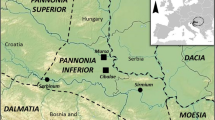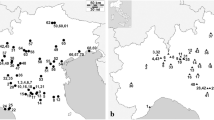Abstract
The aim of this archaeobotanical and archaeological research is to expand knowledge about Roman diet and plant cultivation in Istria and to compare it with similar localities on the Eastern Adriatic coast. We have also tried to find some new information about maritime trade routes in the Mediterranean area in ancient times. Out of 27 samples collected from an excavated Roman port in Flacius Street in Pula, in total, 9809 plant macrofossils were recovered, identified and analysed. The results of the analysis show that most of the plant remains belong to the group of fruit trees and nuts. The most abundant are the remains of Ficus carica, Pinus pinea, Vitis vinifera subsp. vinifera, Rubus fruticosus agg. and Olea europaea subsp. europaea. These are all species that are widespread in the Mediterranean area and have likely always been consumed by the local population. The number of ruderal and weed species found is relatively high (31) in comparison with other plant categories (fruit trees and nuts; fruit collected from the wild; cereals; condiments; oil crops; vegetables and tubers; plants of fresh water environments; elements of maquis), but as they came to the site accidentally and not by targeted human activity, there are far fewer macrofossils of such plants than those of cultivated species. There were a few elements of evergreen forest vegetation and plants of aquatic habitats at the site (2 + 1), which suggests the existence of this type of vegetation in the area of the site in Roman times. Archaeobotanical comparisons of the site in Flacius Street with similar coastal Roman sites—Verige Bay on Veli Brijuni (first-fifth century ad), the port of Zaton near Nin (first-third century ad) and Caska Bay on the island of Pag (first and second century ad)—reveal considerable similarities, confirming the uniformity in nutrition and plant growth in the wider coastal area. Together with the two Roman ships, during the archaeological excavations of the Roman harbour and its layers, we collected over 2000 different archaeological artefacts out of which a large number was almost perfectly preserved. Some of the mentioned artefacts include ceramic amphorae, ceramic table- and kitchenware, ceramic lamps, different usable objects made of glass, wooden use objects, parts of ship’s equipment and other wooden tools, architecture elements from the nearby port as well as residential structures and remains of stone monuments. Because of the large amount of artefacts found at the site, the analysis of the artefacts and data processing are still in progress. As a contribution for recognizing organic remains, we isolated the amphorae whose purpose was the storage and maritime transportation of different food products and ingredients.






















Similar content being viewed by others
References
Antolin F, Jacomet S (2015) Wild fruit use among early farmers in the Neolithic (5400-2300 cal BC) in the north-east of the Iberian peninsula: an intensive practise? Veget Hist Archaeobot 24:19–33
Arnaud P (2005) Les routes de la navigation antique. Itinéraires en Méditerranée, Paris
Auriemma R (2000) Le anfore del relitto di Grado e il loro contenuto, in MEFRA 112, 1, pp 27–51
Auriemma A, Degrassi V, Quiri E (2012) Produzione e circolazione di anfore in Adriatico tra III e IV secolo: dati da contesti emblematici. Trieste antica: lo scavo di Crosada: pp 153–195
Behre KE, Jacomet S (1991) The ecological interpretation of archaeobotanical data. In: van Zeist W, Wasylikowa K, Behre KE (eds) Progress in old world paleoethnobotany. Balkema, Rotterdam, pp. 81–108
Beltrame (2013) Fragment of boats from the Canale Anfora of Aquileia, Italy, and comparison of sewn-plank ships in the roman era. Int J Naut Archaeol 42(2):296–304
Beltran M L (1970) Las ánforas romanas en Espaňa. Zaragoza
Beug H-J (1977) Vegetationsgeschichtliche Untersuchungen im Kstenbereich von Istrien (Jugoslawien). Flora 166:357–381
Bezeczky T (1993) Knidischen Amphoren in den nordlichen Provinzen des romischen Reiches. Carinthia I 183:237–244
Bezeczky T (1995) Amphorae and amphora stamps from the Laecanius workshop. Journal of Roman Archaeology 8 :41–64Michigan
Bezeczky T (1998) The Laecanius Amphora stamps and the Villas of Brijuni. Wien
Boetto G, Radić Rossi I (2011) Šivani brod u uvali Caska na Pagu – Istraživačka kampanja 2010. Histria Antiqua 20:505–513
Boetto G, Rousse C (2011) Le chaland de Lipe (Ljubljana, Slovenie) et la tradition de construction „sur sole“ de l’Europe sud – orientale: quelles influences méditerranéennes?, Batellerie Gallo – Romaine, Pratiques régionales et influences maritimes méditerranéennes. Biama 9: pp 178–191
Boetto G, Koncani Uhač I, Uhač M (2014) I. Navires de l’âge du Bronze à l’époque romaine en Istrie. Dossiers d’Archéologie 364:22–25
Bonifay M (2004) Études sur la céramique romaine tardive d’Afrique. British Archaeological Report, International Series 1301, Oxford
Bouby L, Bouchette A, Figueiral I (2011) Sebesten fruits (Cordia myxa L.) in Gallia Narbonensis (southern France): a trade item from the eastern Mediterranean? Veget Hist Archaeobot 20:397–404
Brus R (2012) Drvesa in Grmi Jadrana. Modrijan založba, Ljubljana
Brusin G (1934) Gli scavi di Aquileia, Udine
Bulić D, Koncani Uhač I (2010) The pottery workshop at Fažana and its transformation in the late Roman period. Histria Archaeologica 41:109–146
Buršić Matijašić K (2006) Luka Pula u prapovijesno i rimsko doba. Zbornik radova: Iz povijesti Pulske luke, Pula: pp 5–43
Cappers RTJ, Bekker RM, Jans JEA (2006) Digitale Zadenatlas van Nederland (digital seed atlas of the Netherlands). Barkhuips publishing & Groningen, University library Groningen, Groningen
Caravale A, Toffoletti I (1997) Anfore Antiche: Conoscerle e Identificarle.
Carre MB, Maselli Scotti F (2001) Il porto di Aquileia: Dati antichi e ritrovamenti recenti, Antichità Altoadriatiche 46. Trieste – Roma, pp: 211–243
Carre M B, Pesavento S, Belotti C (2009) Le anfore da pesce adriatiche. Antenor Quaderni 15, Roma: pp. 215–238
Cipriano M T, Carre M B (1989) Production et typologie des amphores sur la côte adriatique de l’Italie. Anfore romane e storia economica. Diecci anni di richerce, CollÉeFrome 114, Rome: pp. 67–104
De Franceschi C (1934) C. Il ninfeo e l’acquedotto di Pola romana. Atti e Memorie della Società Istriana di Archeologia e Storia Patria XLVI: pp 229–249
De Ville A (1991) Starina u luci i gradu Puli i lov na tune, "Istra", XXIX, 119., Pula, (Portus et urbis Polae antiquitatum ut et thynnorum piscationis, 1633): pp 3–26
Degrassi A (1954) I porti romani dell’ Istria. Atti e memorie della Società istriana di archeologia e storia patria 5:24–81
Degrassi A (1962) Salvore – Scoperta d’antichità romane, Scritti vari di antichità, II, Roma: pp 881–886
Erhardt W, Gotz E, Bödeker N, Seybold S (2014) Zander – Handworterbuch der Pflanzennamen (19. Aufl.). Eugen Ulmer GmbH & Co., Stuttgart
Fraschetti A (1983) La Pietas di Cesare e la colonia di Pola, Annali del seminario di studi del mondo classico, Archeologia e storia antica 5:77–101
Giovannini A, Ventura P (2010) Il Museo archeologico nazionale di Aquileia, una storia che parte da lontano realtà e riorganizzazione futura, Forma Urbis, Itinerari nascosti di Roma antica, 12/15, Roma, pp 34–36
Gluščević S, Jurišić M, Šoštarić R, Vujčić Karlo S (2006) Evidence for the nutrition of sailors from the Roman harbour at Zaton near Zadar. Archaeologia maritima mediterranea 1/2004: pp 41–52
Gnirs A (1910) Forschungsergebnisse aus dem südlichen Istrien, Jahreshefte des Österreichischen Archäologischen Instituts, 13 Wien, pp 95–106
Gnirs A (1911) Forschungen in Istrien. Jahreshefte des Österreichischen Archäologischen Instituts 14:188–194
Jacomet S (2010) Practical course: identification of archaeological plant macrofossils (seeds and fruits) MSc “prehistory and archaeological science”. IPNA, Universität Basel, Basel
Kandler P (1845) Inscrizioni dei tempi romani rinvenute nell’Istria, Trieste
Kislev M (2008) Archaeobotanical evidence of birdliming at Ashkelon. In: Stager LE, Schloen D, Master DM (eds) The Leon levy expedition to Ashkelon, Ashkelon 1, introduction and overview (1985–2006). Winona Lake, Indiana, Eisenbrauns, pp. 131–140
Koncani Uhač I, Uhač M (2012) Prapovijesni brod iz uvale Zambratija – prva kampanja istraživanja. Histria Antiqua 21:533–538
Kozličić M (2006) Istočni Jadran u djelu Beautemps-Beauprea. Hrvatski hidrografski institut, Split.
Krajačić M (2009) Biljni makrofosili iz antičke luke u Zatonu kraj Nina. Dissertation. Universitty of Zagreb
Krizmanić A (2005) Prostorni razvitak austrijske Pule. Tri tisućljeća mita i stvarnosti. Pula, pp 113–192
Mandruzzato L (1996) Immobile Pasqualis, Notiziario archeologico „AN“, 67, pp 264–267
Maselli Scotti F (2008) Il porto di Tergeste: riflessioni a seguito dei recenti rinvenimenti. Terre di mare. L’archeologia dei paesaggi costieri e le variazioni climatiche, Trst, pp 317–327
Maselli Scotti F, Ventura P (2001) Strutture portuali di Tergeste romana, Antichità Altoadriatiche, 46, Trieste – Roma, pp 201–209
Matijašić R (1988) Ageri antičkih kolonija Pola i Parentium i njihova naseljenost od I. do III. stoljeća, Zagreb.
Matijašić R (2001) I porti dell’Istria e della Liburnia, u: "Strutture portuali e rotte marittime nel-l’Adriatico di età romana", Antichità Altoadriatiche, 46, Trieste – Roma, pp 161–174.
Matijašić R (2006) Mreža luka u Istri – od Rižane do Raše – u starom vijeku, u “Luke istočnog Jadrana”, Zbornik Pomorskog muzeja Orebić, Orebić, pp 51–66.
Neef R, Cappers RTJ, Bekker RM (2012) Digital atlas of economic plants in archaeology. Barkhuis & Groningen, University library Groningen, Groningen
Peacock D P S, Williams D F (1986) Amphorae and the Roman economy: an introductory guide. New York
Plants for a future - database. 1996–2012., https://www.google.hr/search?q=Plants+for+the+future&oq=Plants+for+the+future&aqs=chrome.69i57j69i59l2j0l3.4414j0j4&sourceid=chrome&es_sm=93&ie=UTF-8, Accessed Sept 2015
Riley, J A (1979) The coarse pottery from Berenice, in J. A. Lloyd (ed.), Excavations at Sidi Khrebish Benghazi (Berenice), Vol. II (Supplement to Libya Antiqua 5), pp 91–467
Royal JG, Tusa S (2012) The Levanzo I wreck, Sicily: a 4th-century AD merchantma in the service of the annona? Int J Naut Archaeol 41(1):26–55
Sandrini GM (1988) Cinque pozzi romani ad Oderzo. Quaderni Veneti 4:63–68
Šoštarić R, Küster H (2001) Roman plant remains from Veli Brijun (island of Brioni). Croatia Veget Hist Archaeobot 10:227–233
Suić M (2003) Antički grad na istočnom Jadranu, 2. izmijenjeno i dopunjeno izdanje, Zagreb.
Tillier M (2012) Etude carpologique des structures portuaires immerges du site Romain de Caska (ile de Pag, Croatie). Dissertation, Montpellier, Université Paul Valéry
Toniolo A (1987) I contenitori da trasporto di epoca romana nel Polesine di Rovigo, Archeologia Veneta, X, pp 87–128
Trinajstić I (1975) Kronološka klasifikacija antropohora s osvrtom na helenopaleofite Jadranskog primorja Jugoslavije. Biosistematika 1(1):79–85
Yriarte Ch (1999) Istra i Dalmacija: putopis. Antibarbaru, Zagreb.
Zohary D, Hopf M (1988) Domestication of plants in the old world—the origin and spread of cultivated plants in West Asia, Europe, and the Nile Valley. Oxford University Press, New York
Zohary D, Hopf M, Weiss E (2012) Domestication of plants in the old world, the origin and spread of domesticated plants in Southwest Asia, Europe, and the Mediterranean Basin. Oxford University Press, Oxford
Author information
Authors and Affiliations
Corresponding author
Rights and permissions
About this article
Cite this article
Essert, S., Koncani-Uhač, I., Uhač, M. et al. Plant remains and amphorae from the Roman harbour under Flacius Street in Pula (Istria, Croatia). Archaeol Anthropol Sci 10, 955–971 (2018). https://doi.org/10.1007/s12520-016-0410-4
Received:
Accepted:
Published:
Issue Date:
DOI: https://doi.org/10.1007/s12520-016-0410-4




